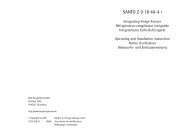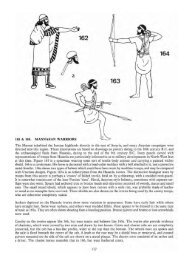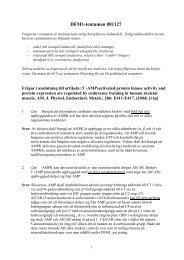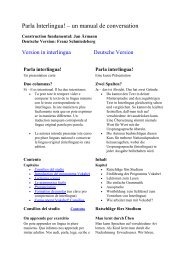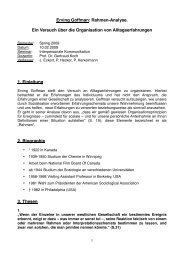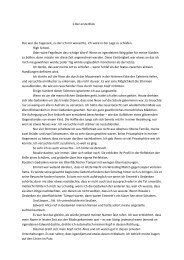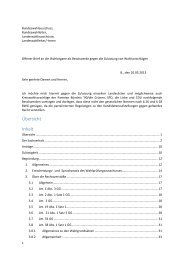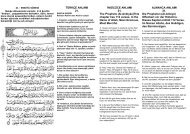Removal and Replacement of the Boxster convertible top - Wikia
Removal and Replacement of the Boxster convertible top - Wikia
Removal and Replacement of the Boxster convertible top - Wikia
You also want an ePaper? Increase the reach of your titles
YUMPU automatically turns print PDFs into web optimized ePapers that Google loves.
DIY <strong>Boxster</strong> Convertible Top Canvas R & R<br />
Sincere thanks to Fred Adler for <strong>the</strong> pictures <strong>and</strong> instructions, <strong>and</strong> to o<strong>the</strong>rs for helping me acquire<br />
<strong>the</strong>m.<br />
I resized <strong>the</strong> pictures to keep <strong>the</strong> file size down, <strong>and</strong> matched <strong>the</strong>m up with <strong>the</strong> text for easy<br />
reading/printing in PDF form.<br />
Chris in NH, 4/24/2007<br />
1
<strong>Removal</strong> <strong>and</strong> <strong>Replacement</strong> <strong>of</strong> <strong>the</strong> <strong>Boxster</strong> <strong>convertible</strong> <strong>top</strong><br />
I never started out to remove <strong>and</strong> replace <strong>the</strong> <strong>convertible</strong> <strong>top</strong> on my 1998 <strong>Boxster</strong> but I always believe<br />
in researching <strong>and</strong> underst<strong>and</strong>ing a repair prior to getting quotes on it. My <strong>Boxster</strong> is my seventh<br />
Porsche always buying <strong>the</strong>m used <strong>and</strong> it co-resides next to my “retro” <strong>Boxster</strong>, a 1971 914. The 914<br />
taught me that when Porsches get old <strong>the</strong>y are still loved as much as those rolling out <strong>of</strong> <strong>the</strong> local<br />
dealership <strong>and</strong> that a place like Pelican Parts tech reports can <strong>of</strong>fer a simple alternative to finding<br />
someone who might know about your “older car” or a dealership that might know about your car. I<br />
have used <strong>the</strong> 914 tech reports <strong>and</strong> forums to fix, replace <strong>and</strong> keep driving my “retro” <strong>Boxster</strong>.<br />
When my <strong>Boxster</strong> back window finally gave up enough <strong>of</strong> its plasticizer to crack <strong>and</strong> split after eight<br />
years in <strong>the</strong> California sun, <strong>the</strong> first place I went for guidance was <strong>the</strong> <strong>Boxster</strong> tech section. I found<br />
that <strong>the</strong>re was no help on “doing it myself”. I have replaced <strong>top</strong>s twice before on previously owned<br />
MGB’s which primitive, manual <strong>top</strong>s available from many OEM sources. Those <strong>top</strong>s like <strong>the</strong> ones found<br />
a lot <strong>of</strong> o<strong>the</strong>r small roadsters seem to cost between $200 <strong>and</strong> $400 dollars <strong>and</strong> are ra<strong>the</strong>r simply put<br />
on by any patient owner. I also tried repairing <strong>the</strong> back window with one <strong>of</strong> those “window<br />
replacement” deals selling you “everything you need to sew in a new window”. It did not work well<br />
<strong>and</strong> after two days with bloody fingers sewing through that incredibly tough German canvas, it leaked<br />
<strong>and</strong> looked bad………………so on to <strong>the</strong> total <strong>top</strong> replacement.<br />
I began researching all <strong>of</strong> <strong>the</strong> <strong>Boxster</strong> websites <strong>and</strong> chat rooms <strong>and</strong> all that I could find are discussions<br />
<strong>of</strong> where to buy <strong>top</strong>s for between $500 <strong>and</strong> $900 dollars followed by $1000 to $1800 labor costs to put<br />
<strong>the</strong>m on. I checked ebay for <strong>top</strong>s <strong>and</strong> found <strong>the</strong> different varieties including ones with updated glass<br />
windows ranging from $390 to $1000. When you contact those sellers <strong>the</strong>y recommended a<br />
“pr<strong>of</strong>essional” installer for installation. Most <strong>of</strong> those installation quotes including <strong>top</strong>s are $2000 <strong>and</strong><br />
up. When I related this to Pelican Parts chat rooms, <strong>the</strong>y said that perhaps I should try myself <strong>and</strong><br />
take a lot <strong>of</strong> pictures for future <strong>Boxster</strong> owners. If <strong>Boxster</strong>s do what 914’s have, most people will be<br />
trying to replace <strong>top</strong>s <strong>the</strong>mselves 10 or 30 years from now.<br />
And so, here we go. It is not easy to do <strong>and</strong> takes as much “artistic” sense as basic “h<strong>and</strong>y” skills.<br />
First, choose a <strong>top</strong>. If you search <strong>the</strong> web <strong>the</strong>re will be many. I decided to replace <strong>the</strong> old <strong>top</strong> with<br />
one most like <strong>the</strong> original since <strong>the</strong> updated glass window ones are more expensive <strong>and</strong> seem to have<br />
“issues” which may compromise <strong>the</strong> expensive parts <strong>and</strong> lifting mechanism found in earlier models (up<br />
to 2004). I decided on a <strong>top</strong> made from “German canvas” (a heavy canvas like <strong>the</strong> original with a<br />
smooth finish on <strong>the</strong> outside <strong>and</strong> a “herringbone” like pattern on <strong>the</strong> inside) with a “green tinted” back<br />
plastic window. I found one on line for about $400. I took it out <strong>of</strong> <strong>the</strong> box for inspection <strong>and</strong> “feel” to<br />
make sure it was as thick as <strong>the</strong> old one.<br />
Then I downloaded what was available on “alldata.com” since one <strong>top</strong> shop told me that is what <strong>the</strong>y<br />
do. I found that information answered some questions but for <strong>the</strong> most part <strong>the</strong> diagrams are cryptic<br />
<strong>and</strong> <strong>the</strong> instructions extremely short. The <strong>Boxster</strong> <strong>top</strong> instructions are between 20 <strong>and</strong> 30 pages but<br />
still not very clear. Once I started on <strong>the</strong> <strong>top</strong>, <strong>the</strong> instructions really did not show my situation that<br />
closely.<br />
Armed with this <strong>and</strong> confidence earned by doing several things to my 914 (fuel lines, electronic fuel<br />
systems, starters, etc. thanks to Pelican), I dove into <strong>the</strong> task <strong>of</strong> <strong>the</strong> <strong>Boxster</strong> <strong>top</strong>. I figured, how bad<br />
could it be even if I just got <strong>the</strong> old one <strong>of</strong>f.<br />
Knowing that a <strong>Boxster</strong> has a lot more parts than a 914, I used <strong>the</strong> old ziplock bag technique to keep<br />
track <strong>of</strong> <strong>the</strong> removal so I would have <strong>the</strong> best chance <strong>of</strong> reassembly correctly with no left over parts. I<br />
parked next to a long table to lay <strong>the</strong> parts out with a box <strong>of</strong> zip lock bags <strong>and</strong> a roll <strong>of</strong> masking tape<br />
to label things as I took <strong>the</strong>m <strong>of</strong>f. You need to make sure it is really nice <strong>and</strong> warm in your working<br />
area so <strong>the</strong> canvas <strong>top</strong> you will be putting on <strong>and</strong> taking <strong>of</strong>f will be supple <strong>and</strong> as s<strong>of</strong>t <strong>and</strong> loose as<br />
possible.<br />
2
Here goes <strong>the</strong> <strong>top</strong> removal <strong>and</strong> installation:<br />
1. Put <strong>the</strong> <strong>top</strong> in “service mode” which is opening <strong>the</strong> <strong>top</strong> from 12 to 18 inches. (Figure 1) Take out<br />
<strong>the</strong> key so <strong>the</strong>re no chance <strong>of</strong> fur<strong>the</strong>r motion. Remove <strong>the</strong> seat wind s<strong>top</strong> <strong>and</strong> seat head rest wind<br />
s<strong>top</strong>s to give you more room to work. Also if you have <strong>the</strong> console which fits behind <strong>the</strong> seats,<br />
unlock <strong>and</strong> remove that also after unclipping <strong>the</strong> rear drape over <strong>the</strong> engine.<br />
2. Uncouple <strong>the</strong> two cables on ei<strong>the</strong>r side from <strong>the</strong> rear. (Figure 2) You have to do all <strong>of</strong> this if you<br />
have ever opened <strong>the</strong> rear up for SMOG inspection. No smog guy will know how to do this <strong>and</strong> you<br />
should know this routine anyway.<br />
Now you are in “service mode” <strong>and</strong> you have removed <strong>the</strong> easy things.<br />
3
With <strong>the</strong> gap in <strong>the</strong> front <strong>of</strong> <strong>the</strong> <strong>top</strong> exposed you can see <strong>the</strong> front edge retaining rail. (Figure 3)<br />
On my 1998, this retaining rail holds in <strong>the</strong> wea<strong>the</strong>r seal <strong>and</strong> it held to <strong>the</strong> <strong>top</strong> frame by six T20 star<br />
screws. Remove <strong>the</strong>se six T20 screws. Remove also <strong>the</strong> two T20 star screws holding in <strong>the</strong> left <strong>and</strong><br />
right h<strong>and</strong> corners <strong>of</strong> <strong>the</strong> front <strong>convertible</strong> <strong>top</strong> seal. Bag <strong>the</strong> screws <strong>and</strong> label where <strong>the</strong>y came from.<br />
You can now remove <strong>the</strong> front retaining rail <strong>and</strong> set it aside. With <strong>the</strong> doors open, you can also<br />
carefully pull out <strong>the</strong> front <strong>convertible</strong> <strong>top</strong> seal which goes across <strong>the</strong> front <strong>of</strong> <strong>the</strong> <strong>top</strong> frame <strong>and</strong> along<br />
both right <strong>and</strong> left sides <strong>of</strong> <strong>the</strong> <strong>top</strong> at <strong>the</strong> <strong>top</strong> <strong>of</strong> <strong>the</strong> window frame area. (Figure 4)<br />
4
3 Next you will approach removal <strong>of</strong> <strong>the</strong> sides <strong>of</strong> <strong>the</strong> ro<strong>of</strong> frame. The seal at <strong>the</strong> sides <strong>of</strong> <strong>the</strong> ro<strong>of</strong><br />
frame was held on by a lower “U” shaped bracket. This is where alldata.com was wrong for my<br />
<strong>top</strong>. They did not have <strong>the</strong> front <strong>and</strong> side seals as one part as mine was. The “U” shaped bracket<br />
around 12” in length is held on by 4 T10 star screws. ( Figure 5)<br />
Remove each side labeling <strong>the</strong>m with <strong>the</strong> masking tape as passenger <strong>and</strong> driver side <strong>and</strong> bag <strong>the</strong><br />
screws. Once <strong>the</strong> side wea<strong>the</strong>rstrip holder is removed, you will see four Philips screws. Remove<br />
<strong>the</strong>se screws on each side (passenger <strong>and</strong> driver) <strong>and</strong> bag <strong>and</strong> label <strong>the</strong>m. (Figure 6)<br />
5
4 Now starts <strong>the</strong> “manual” part” <strong>of</strong> removal. You will note that <strong>the</strong> canvas is likely held on with a<br />
double sided adhesive tape. I went to my local Auto Paint shop <strong>and</strong> purchased a roll <strong>of</strong> 3M auto<br />
body tape to replace this when reinstalling a new <strong>top</strong>. You will need at this time to start “peeling<br />
back” <strong>the</strong> old <strong>top</strong> from <strong>the</strong> front edge. With everything that you have removed thus far, you can<br />
peel back <strong>the</strong> front edge <strong>and</strong> continue carefully (carefully so as not to damage <strong>the</strong> <strong>top</strong> frame, bend<br />
it in any way) along both sides. The same double edged adhesive tape that was used on <strong>the</strong> front<br />
edge was also used along both sides. Now <strong>the</strong> <strong>top</strong> is peeled back to <strong>the</strong> center support beam <strong>of</strong><br />
<strong>the</strong> ro<strong>of</strong> frame. (Figure 7)<br />
(…<strong>and</strong> Figure 8)<br />
6
5 This exposes two aluminum guide sheets on ei<strong>the</strong>r side that fit flush on <strong>the</strong> ro<strong>of</strong> <strong>and</strong> to which are<br />
attached <strong>the</strong> cables which guide <strong>the</strong> <strong>top</strong> around <strong>the</strong> window frames when raising <strong>and</strong> lowering <strong>the</strong><br />
<strong>top</strong>. (Figure 9)<br />
The cable goes from <strong>the</strong> center point underneath <strong>the</strong> aluminum plate around <strong>the</strong> back <strong>of</strong> <strong>the</strong><br />
window frame <strong>and</strong> down to a point just below <strong>the</strong> body on <strong>the</strong> “B pillar” (<strong>the</strong> ro<strong>of</strong> support pillar just<br />
behind <strong>the</strong> window areas). You do not have to worry about <strong>the</strong> cables since <strong>the</strong>se are provided by<br />
<strong>the</strong> <strong>top</strong> manufactures sewed into <strong>the</strong> new <strong>top</strong>. I did not cut <strong>the</strong>m but ra<strong>the</strong>r was careful with <strong>the</strong>m<br />
since you must now bend <strong>the</strong> aluminum guides to which <strong>the</strong>y are attached since <strong>the</strong>y need to lay<br />
flush under <strong>the</strong> new <strong>top</strong>. The cables on mine were attached to <strong>the</strong> aluminum plates by way <strong>of</strong> a<br />
rivet. The cable was attached to a spring <strong>and</strong> <strong>the</strong> spring was riveted to <strong>the</strong> aluminum plate. This<br />
assembly (spring <strong>and</strong> cable end) were shrink wrapped in plastic. I cut <strong>the</strong> shrink wrap with a razor<br />
blade <strong>and</strong> unhooked <strong>the</strong> cable “eye”. Peel <strong>the</strong> canvas <strong>top</strong> <strong>of</strong>f <strong>of</strong> <strong>the</strong> aluminum sheets careful not to<br />
bend <strong>the</strong>m, label <strong>the</strong> aluminum plates passenger <strong>and</strong> driver side <strong>and</strong> set aside. (Figure 10)<br />
7
6 Now you will need to detach <strong>the</strong> o<strong>the</strong>r side <strong>of</strong> <strong>the</strong> cable you have just been working with. As I said<br />
earlier, this cable terminates on <strong>the</strong> o<strong>the</strong>r end (<strong>the</strong> end fastened to <strong>the</strong> “B pillar” (<strong>the</strong> pillar behind<br />
<strong>the</strong> windows), below <strong>the</strong> body line <strong>of</strong> <strong>the</strong> car. To get at this screw, lower <strong>the</strong> <strong>top</strong> about 75%. This<br />
screw <strong>and</strong> cable will become visible. (Figure 11)<br />
This was again a T20 star screw. You will note that <strong>the</strong> screw goes through a flap on <strong>the</strong> <strong>top</strong>, <strong>the</strong><br />
lower cable eye, a plastic part which runs up from <strong>the</strong> screw called <strong>the</strong> “clamping rail <strong>and</strong> slider”<br />
<strong>and</strong> into <strong>the</strong> B pillar. Carefully remove <strong>the</strong> screw <strong>and</strong> DON”T DROP IT” since it will be really<br />
difficult to retrieve. When removed from passenger <strong>and</strong> driver side, bag <strong>the</strong>m <strong>and</strong> label <strong>the</strong>m.<br />
They have a lock washer. Remember <strong>the</strong> clamping rail <strong>and</strong> slider for later.<br />
7 Now you are back to <strong>the</strong> middle support frame. The <strong>top</strong> has a flap <strong>and</strong> piping which was slid into a<br />
plastic cover on this middle frame. (Figure 12) Note that <strong>the</strong>re is a metal clip which holds this<br />
plastic cover onto <strong>the</strong> middle frame. Pry it <strong>of</strong>f, noting how it was snapped in place. Now <strong>the</strong><br />
plastic frame will lift <strong>of</strong>f <strong>and</strong> you can slide <strong>the</strong> canvas flap out <strong>of</strong> it. Set aside <strong>the</strong> plastic cover for<br />
<strong>the</strong> middle frame.<br />
8
8 At this point, I felt like I wanted to work elsewhere so I went to rear <strong>of</strong> <strong>the</strong> <strong>top</strong> <strong>and</strong> started<br />
removing it. Put <strong>the</strong> <strong>top</strong> back up to about 12-18 inches open. First <strong>the</strong>re is a push in wea<strong>the</strong>r strip<br />
which seals <strong>the</strong> trunk from <strong>the</strong> <strong>top</strong>. This pulls out easily. Be careful since <strong>the</strong> replacement Porsche<br />
part is no doubt expensive <strong>and</strong> this sort <strong>of</strong> wea<strong>the</strong>r strip like <strong>the</strong> front seal can be torn. Put is<br />
aside labeling <strong>top</strong> <strong>and</strong> bottom with masking tape. Carefully peel up <strong>the</strong> <strong>top</strong> from <strong>the</strong> wea<strong>the</strong>r strip<br />
channel. Yes, more <strong>of</strong> that infernal double-sided adhesive tape. (Figure 13 <strong>and</strong> 14)<br />
9
This exposes ano<strong>the</strong>r flat wea<strong>the</strong>r strip to <strong>the</strong> rear <strong>of</strong> ano<strong>the</strong>r push in piece <strong>of</strong> plastic striping. Pull<br />
out <strong>the</strong> flat push down wea<strong>the</strong>r strip on <strong>the</strong> rearmost part <strong>of</strong> <strong>the</strong> frame. Because you have <strong>the</strong> <strong>top</strong><br />
in “service mode”, <strong>the</strong> rear part <strong>of</strong> <strong>the</strong> <strong>top</strong> hinges loose <strong>and</strong> <strong>the</strong>se strips are easier to remove.<br />
Carefully pull out this wea<strong>the</strong>r strip as well, label it <strong>and</strong> put it aside. Now for <strong>the</strong> <strong>top</strong> attachment to<br />
<strong>the</strong> rearmost part <strong>of</strong> <strong>the</strong> frame. Yes <strong>the</strong> adhesive was partly responsible, but <strong>the</strong> <strong>top</strong> also has a<br />
flap which was inserted in ano<strong>the</strong>r grove parallel to <strong>the</strong> last wea<strong>the</strong>r strip that you removed held in<br />
place by a long wedge shaped piece <strong>of</strong> plastic that fits into that groove after <strong>the</strong> <strong>top</strong> flap in <strong>the</strong> rear<br />
was inserted into it. Pull this out <strong>and</strong> <strong>the</strong> canvas is now loose from <strong>the</strong> rearmost frame bar. (Figure<br />
15)<br />
9 Now back to those “clamping rails <strong>and</strong> sliders” that you were working on just behind <strong>the</strong> “B Pillar”.<br />
You loosened <strong>the</strong>m from <strong>the</strong> car when you unscrewed <strong>the</strong> back end <strong>of</strong> <strong>the</strong> <strong>top</strong> cables. They are<br />
also held on by a couple very fragile pins. The “clamping rail <strong>and</strong> slider assembly” is a two part<br />
assembly held toge<strong>the</strong>r <strong>and</strong> to <strong>the</strong> car by two black plastic pins. These act like “hinge” pins on <strong>the</strong><br />
assembly with <strong>the</strong> lower one holding <strong>the</strong> two plastic parts toge<strong>the</strong>r <strong>and</strong> <strong>the</strong> upper one acting as a<br />
guide along which <strong>the</strong> clamping rail <strong>and</strong> slider can slide back <strong>and</strong> forth a few centimeters. Pull<br />
<strong>the</strong>se two pins on each side with a long nose pliers being careful not to damage <strong>the</strong> clamping rail<br />
<strong>and</strong> slider assembly or you will be going to <strong>the</strong> Porsche dealer ordering those parts. Now you will<br />
note that with <strong>the</strong>se two parts disassembled on each passenger <strong>and</strong> driver side that again <strong>the</strong>re<br />
are <strong>top</strong> canvas flaps tucked into each component. Slide <strong>the</strong> <strong>top</strong> flaps out <strong>of</strong> <strong>the</strong>m <strong>and</strong> remove<br />
<strong>the</strong>m labeling <strong>the</strong>m passenger <strong>and</strong> driver <strong>and</strong> noting how <strong>the</strong>y went toge<strong>the</strong>r. I reassembled <strong>the</strong>m<br />
so I could not forget how <strong>the</strong>y go toge<strong>the</strong>r although it is ra<strong>the</strong>r obvious.<br />
10
10 You are almost THERE!! On <strong>the</strong> <strong>top</strong> support going across from <strong>the</strong> B Pillar you will note two canvas<br />
straps screwed into <strong>the</strong> cross support by two each T20 star screws. Unfasten those <strong>and</strong> put aside.<br />
(Figure 16)<br />
You will also notice two (one on each side) Velcro’ed loops holding <strong>the</strong> <strong>top</strong> on <strong>the</strong> sides <strong>of</strong> <strong>the</strong><br />
frame (“push bars”). Open those up. (Figure 17)<br />
11
11 You will now note that it seems like <strong>the</strong>re is only one thing left holding on <strong>the</strong> <strong>top</strong>. You are right.<br />
The canvas <strong>top</strong> has ano<strong>the</strong>r flap behind <strong>the</strong> flap that was slid into <strong>the</strong> #2 bar going across by way<br />
<strong>of</strong> that plastic cover. This flap, however, on bar #3 (#1 is <strong>the</strong> front one), is slid right into <strong>the</strong> bar.<br />
When you slide it out, <strong>the</strong> <strong>top</strong> comes OFF. You will figure out that this is <strong>the</strong> very first thing you do<br />
in reverse on assembly. There is no way to get this flap in place when anything else is fastening<br />
<strong>the</strong> <strong>top</strong> to <strong>the</strong> frame.<br />
12 OK <strong>the</strong> <strong>top</strong> is OFF, about 2-3 hours later than you started <strong>and</strong> you have <strong>the</strong> whole process fresh in<br />
your mind. For installation, you have to make sure you have that double sided adhesive tape (3M<br />
Automotive, Figure 18),<br />
…<strong>and</strong> some denatured alcohol (Home Depot) to clean <strong>the</strong> areas to which you plan to apply <strong>the</strong> new<br />
tape. Clean <strong>and</strong> pull <strong>of</strong>f all <strong>the</strong> old double sided tape from <strong>the</strong> front edge <strong>of</strong> <strong>the</strong> frame, <strong>the</strong> sides on<br />
<strong>the</strong> aluminum parts, <strong>the</strong> back edge <strong>and</strong> anywhere else that <strong>the</strong> installer may have put it. I suspect<br />
that some people put more on since fitting <strong>the</strong> new <strong>top</strong> is no picnic. It takes a lot checking <strong>and</strong><br />
rechecking for evenness <strong>and</strong> position.<br />
12
13 Take <strong>the</strong> OLD <strong>top</strong> now <strong>and</strong> compare it to <strong>the</strong> new on to make sure it is almost <strong>the</strong> same if not<br />
perfectly <strong>the</strong> same. I am sure that Porsche made changes along <strong>the</strong> way. Also assure that <strong>the</strong><br />
new one has <strong>the</strong> new cables sewn into <strong>the</strong> channels on both sides <strong>of</strong> <strong>the</strong> new canvas.<br />
14 NOW, reverse <strong>the</strong> process for installation. Remember <strong>the</strong> very first thing to do is to slide <strong>the</strong> #3<br />
channel flap into that flap. Next, I reassembled <strong>the</strong> clamping rail <strong>and</strong> slider assemblies on ei<strong>the</strong>r<br />
side. Remember to match <strong>the</strong> flaps on <strong>the</strong> new <strong>top</strong> to <strong>the</strong> appropriate slots on <strong>the</strong> clamping rail<br />
<strong>and</strong> sliders <strong>and</strong> slide <strong>the</strong>m in. With <strong>the</strong> flaps slid in place, you can assemble <strong>the</strong> two parts <strong>of</strong> <strong>the</strong><br />
clamping rail <strong>and</strong> slider <strong>and</strong> gently position <strong>the</strong>m back into <strong>the</strong>ir original locations. You will have to<br />
tuck parts <strong>of</strong> <strong>the</strong> <strong>top</strong> between <strong>the</strong> body <strong>of</strong> <strong>the</strong> car <strong>and</strong> <strong>the</strong> B Pillar like <strong>the</strong> way <strong>the</strong>y originally were<br />
fit. Put <strong>the</strong> <strong>top</strong> attached to <strong>the</strong> clamping rail <strong>and</strong> slider back into position (assembled) <strong>and</strong> line up<br />
<strong>the</strong> bottom <strong>of</strong> <strong>the</strong>m with <strong>the</strong> cable screw hole <strong>and</strong> <strong>the</strong> black plastic pin positions <strong>and</strong> reinsert <strong>the</strong><br />
pins to hold <strong>the</strong>m toge<strong>the</strong>r in place.<br />
15 Lower <strong>the</strong> <strong>top</strong> 75% making sure that <strong>the</strong> clamping rail <strong>and</strong> slider assemblies don’t move <strong>and</strong> attach<br />
<strong>the</strong> lower end <strong>of</strong> <strong>the</strong> <strong>top</strong> cable through a tab in <strong>the</strong> <strong>top</strong> at that location (you may need to punch a<br />
hole in <strong>the</strong> tab as I did), <strong>the</strong> lock washer, <strong>the</strong> cable eye into <strong>the</strong> hole <strong>and</strong> tighten <strong>the</strong>m.<br />
16 I now went around back again. Raise <strong>the</strong> <strong>top</strong> to <strong>the</strong> “service position” again (12-18 inches open).<br />
Start with inserting <strong>the</strong> rear tab into <strong>the</strong> channel <strong>and</strong> holding it in place with <strong>the</strong> “wedge shaped”<br />
plastic strip. I found that using a silicon spray on <strong>the</strong> strips helped enormously getting <strong>the</strong>m into<br />
place <strong>and</strong> flush. I would spray <strong>the</strong> whole strip before inserting. Now <strong>the</strong> <strong>top</strong> canvas rear is<br />
attached to <strong>the</strong> rear cross bar. Push back in, with silicon spray <strong>the</strong> “flat wea<strong>the</strong>r strip” from <strong>the</strong><br />
rear <strong>of</strong> <strong>the</strong> <strong>top</strong>. Next, <strong>the</strong> double sided tape in reverse. Apply to a cleaned surface (denatured<br />
alcohol worked well), <strong>the</strong> double sided tape in <strong>the</strong> channel for <strong>the</strong> trunk wea<strong>the</strong>r stripping.<br />
SMOOTH <strong>the</strong> trailing edge <strong>of</strong> <strong>the</strong> canvas <strong>top</strong> into that channel keeping in mind that it must be<br />
SMOOTH if you are to fit <strong>the</strong> final wea<strong>the</strong>r stripping into that channel. If you got <strong>the</strong> right adhesive<br />
<strong>and</strong> cleaned before applying, it will stay in place when smoo<strong>the</strong>d onto <strong>the</strong> adhesive. Siliconize <strong>the</strong><br />
rear trunk wea<strong>the</strong>r stripping <strong>and</strong> push it into place.<br />
17 Re-attach <strong>the</strong> two canvas strips running back to front with <strong>the</strong> two T20 star screws as <strong>the</strong>y were<br />
when you removed <strong>the</strong>m.<br />
18 Now for <strong>the</strong> side aluminum panels. Attach <strong>the</strong> forward edge <strong>of</strong> <strong>the</strong> cable to <strong>the</strong> spring on each<br />
aluminum panel like when you removed <strong>the</strong>m <strong>and</strong> wrap <strong>the</strong> old shrink that you slit with electrical<br />
tape. The assembly should now lie nicely on <strong>the</strong> <strong>top</strong> (flat to <strong>the</strong> <strong>top</strong>). If it does not you ei<strong>the</strong>r<br />
have <strong>the</strong> passenger at <strong>the</strong> driver side or you put it backwards. It will lay flat with <strong>the</strong> front edge<br />
even with <strong>the</strong> front <strong>top</strong> frame cross bar.<br />
19 Here is where it gets artsy. Pull <strong>the</strong> canvas <strong>top</strong> as even <strong>and</strong> tight to <strong>the</strong> front as you can. Smooth<br />
<strong>the</strong> <strong>top</strong> as much as you can. If it is not even, you won’t be adhering it evenly <strong>and</strong> it will result in<br />
wrinkles on <strong>the</strong> final <strong>top</strong> assembly.<br />
13
20 Apply more <strong>of</strong> <strong>the</strong> double sided adhesive where it was on <strong>the</strong> two aluminum panels. You can<br />
approximate location on <strong>the</strong> canvas by laying it over <strong>the</strong> aluminum <strong>and</strong> marking <strong>the</strong> back side <strong>of</strong><br />
<strong>the</strong> canvas with a marker. (Figure 19)<br />
The canvas will wrap around <strong>the</strong> aluminum as it was when you took it <strong>of</strong>f. It will fit in <strong>the</strong> channel<br />
along side <strong>of</strong> <strong>the</strong> aluminum. You can determine if <strong>the</strong> aluminum is placed correctly since <strong>the</strong> prior<br />
holes in <strong>the</strong> aluminum sheets should line up with <strong>the</strong> holes in <strong>the</strong> frame from <strong>the</strong> under side. This<br />
step takes patience <strong>and</strong> some fooling with it to get it right. Do both sides <strong>and</strong> <strong>the</strong> <strong>top</strong> should be<br />
smooth across. Refasten <strong>the</strong> aluminum panels with <strong>the</strong> canvas covering with <strong>the</strong> Philips screws<br />
from <strong>the</strong> under side. Try to get it right or you will be backing out <strong>of</strong> <strong>the</strong> procedure <strong>and</strong> doing it<br />
again if you don’t like <strong>the</strong> wrinkles.<br />
21 Front edge attachment next. More cleaning <strong>and</strong> more adhesive along <strong>the</strong> front edge. The front<br />
edge will have a lea<strong>the</strong>r or cardboard strip to help you line it up parallel <strong>and</strong> tight. The adhesive<br />
will hold it in place but I also used a couple plastic spring wood clamps to pinch it in place so I can<br />
walk around <strong>and</strong> make sure it was even <strong>and</strong> straight. You will see how <strong>the</strong> corners tuck in but<br />
remember that <strong>the</strong>se are covered by a wea<strong>the</strong>r strip anyway.<br />
22 I now backed <strong>of</strong>f <strong>the</strong> <strong>top</strong> to a comfortable openness so I could get retaining rail <strong>and</strong> wea<strong>the</strong>r strip<br />
back on. With <strong>the</strong> front edge adhered, screw in <strong>the</strong> corners <strong>of</strong> <strong>the</strong> front wea<strong>the</strong>r strip with <strong>the</strong> two<br />
T20 screws. Screw in <strong>the</strong> side wea<strong>the</strong>r strip holders. Siliconize <strong>the</strong> side wea<strong>the</strong>r strip extensions<br />
<strong>of</strong> <strong>the</strong> front wea<strong>the</strong>r strip <strong>and</strong> push <strong>the</strong>m into <strong>the</strong> holders on ei<strong>the</strong>r side.<br />
23 Now you only have <strong>the</strong> front retaining rail left. With <strong>the</strong> wea<strong>the</strong>r strip in front in place, hold up <strong>the</strong><br />
retaining rail <strong>and</strong> line up <strong>the</strong> holes. I used those clamps here to hold <strong>the</strong> assembly while I refastened<br />
<strong>the</strong> front retaining rail.<br />
14
24 Everyone says <strong>the</strong> new <strong>top</strong> will be tight. To help at this point, I moved <strong>the</strong> car out into <strong>the</strong><br />
California sun to heat it up. After about a half hour, I went around back <strong>and</strong> reattached <strong>the</strong> two<br />
cables on ei<strong>the</strong>r side <strong>of</strong> <strong>the</strong> engine compartment. I <strong>the</strong>n backed <strong>of</strong>f <strong>the</strong> <strong>top</strong> about half way <strong>and</strong><br />
<strong>the</strong>n closed it until <strong>the</strong> light on <strong>the</strong> dash went <strong>of</strong>f. That was close enough to catch <strong>the</strong> closing hook<br />
in <strong>the</strong> center <strong>of</strong> <strong>the</strong> inside <strong>of</strong> <strong>the</strong> car <strong>and</strong> swing <strong>the</strong> latch shut. I left <strong>the</strong> car in <strong>the</strong> sun for <strong>the</strong> rest<br />
<strong>of</strong> <strong>the</strong> afternoon <strong>and</strong> <strong>the</strong>n open <strong>and</strong> closed it a few times to assure my satisfaction. (Figure 20) I<br />
reassembled <strong>the</strong> console <strong>and</strong> <strong>the</strong> wind s<strong>top</strong>s <strong>and</strong> voila, I was exhausted.<br />
I hope this helps. There is some art in this. When I was young, I worked in a tailor shop so I am<br />
good at spotting one leg being longer than <strong>the</strong> o<strong>the</strong>r. That helped with this but doing it myself<br />
saved about $1500. I can live with a little wrinkle. If not, you have to loosen up things from <strong>the</strong><br />
first steps again up to where you see <strong>the</strong> wrinkles, likely on <strong>the</strong> sides, <strong>and</strong> smooth it out. Good<br />
luck.<br />
15



